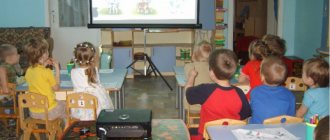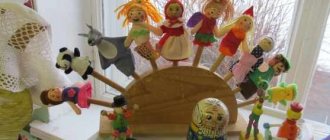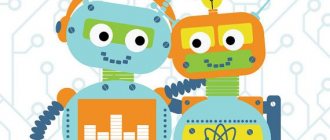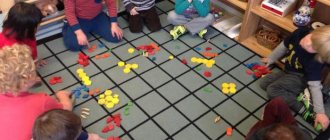Open lesson "Let's feed the chickens"
Author: Bikchentaeva Aigul Faritovna
Summary of a lesson with children of the first junior group in kindergarten using non-traditional drawing techniques “Let's feed the chickens” (drawing with cotton swabs).
Goal: Development of artistic and creative abilities of children of primary preschool age through the use of non-traditional drawing techniques.
Objectives : - educational: to consolidate children’s knowledge about their children’s poultry; to train children in non-traditional artistic techniques: drawing with cotton swabs.
-educational: to educate children to be neat when drawing.
— developmental: develop interest in drawing, develop color perception and hand-eye coordination in children; develop fine motor skills in children;
Materials: picture of chickens, album sheets with pictures of chickens, cotton swabs, black gouache, seeds.
Methods and techniques:
artistic expression, surprise moment, demonstration, explanation, music, imitation, finger gymnastics, exercise, sketch, dance.
Progress of educational activities
Organizational moment.
— Listen to the poem
The shell in the nest crunches
A curious eye shines:
From an egg, like from a diaper, a chick emerges. He stretched, shook himself, quietly squeaked, looked around: “Well, I guess I’ll go and find my parents!”
- What animal did I tell you the poem about?
– These kids came to visit us today (showing a picture with chickens).
Main part
-Do you know what chickens say? Who is the chicken's mother? And dad? Well done! What kind of birds are they? (To the home). What other poultry do you know? (children's answers) - Goose (gosling), - Duck (duckling), - Turkey (turkey chick). Let's play the game "Hen and Chicks." I'll be a chicken. And you are my chickens. Educator:
The chicken went out for a walk and nibbled some fresh grass. And behind her are the guys - Yellow chickens. (Children walk in a circle behind the teacher.) Co-co-co, co-co-co!
Don't go far. Row with your paws, look for grains! (Children imitate the movements of chickens: they row with their paws and peck at grains)
Educator: Oh, the kids are here, there are no grains on the carpet at all, and the chickens have nothing to eat. Let us paint the grains with paint. To do this, we will sit at the table. And before we draw the seeds for the chickens, let’s prepare our fingers.
Finger game:
The hen has a chick, the goose has a gosling, the turkey has a baby turkey, and the duck has a duckling, every mother has babies, all of them are beautiful and good.
Educator : Now I will show you the seeds. What color are they? (black). We dip a cotton swab in black paint and “scatter the grains” across the clearing for the chickens, like this (I show drawing with a cotton swab in the picture of chickens). Kids rhythmically make “spots” with cotton swabs on a sheet of album with a picture of chickens.
-Well done guys, you tried very hard.
Summary of the lesson.
Educator : Children, what did you draw? For whom?
— What is the name of the chicks’ mother?
-What does she call her children?
— How do the chickens respond?
Integration of areas
: Physical development, Cognitive development, Social and communicative development, Speech development, Artistic and aesthetic
comments powered by HyperComments
Theme of the week: “Autumn” (pets and birds).
GCD theme: “Poultry yard”.
Directions of development: speech, artistic and aesthetic.
Target:
continue to expand and activate children's vocabulary based on enriching their ideas about their immediate environment.
Tasks:
— continue to introduce poultry and their young;
- give an initial idea of poultry (rooster-hen-chicks, duck-ducklings), their external differences, recognize the sounds that birds make;
- develop the ability to imitate words, sound combinations, movements;
— enrich and activate the vocabulary on the topic;
— cultivate a caring attitude towards poultry;
- develop the ability to roll out lumps of plasticine in a circular motion, use plasticine carefully, and place molded objects on paper (“bird feeder”).
Materials and equipment:
— laptop, speakers; mp3 player;
— presentation “Poultry yard”;
- modeling materials for each child: plasticine, plates, modeling board, napkins;
— painting “Bird Yard”;
- picture “Chicken” on a ribbon (for each child);
- “Chicken” mask, scarf (for the teacher).
Preliminary work
| With kids | With parents | Teacher to GCD |
| Examination of the series of paintings “Pets and Birds” | Questionnaire “Environmental education of children” Preparing details for creating the “Rural Yard” layout | Study and selection of literature Creating a “Rural Yard” layout |
| Reading fiction: Russian folk tale “Ryaba Hen”; songs “Cockerel”, “The sun has friends” | Selection of fairy tales, poems, riddles on the topic | A selection of fairy tales, poems, riddles, illustrations, books on the topic. |
| D/I: “Magic bag”, “Find the extra one!”, “Guess who’s screaming” | Replenishment of the development environment on the topic | Selection of educational games with attributes, pictures, photographs on the topic. |
— Forms of OD organization
| Children's activities | Forms of joint organization activities |
| Motor | Outdoor game “Big - small legs”, “Chicks and hen”, |
| Gaming | Didactic game “Where are the kids” |
| Communicative | Picture Talk (PowerPoint Slides) Word game "Birds and their babies" |
| Fine | Modeling |
| Cognitive and research | Surprise moment "What's hidden" |
Logic of educational activities
| № | Activities of the teacher | Pupils' activities | Expected Result |
| Motivation. Introductory part. | |||
| 1 | Audio recording: a cockerel is crowing.” An image of a cockerel appears on the screen | They pay attention, consider, answer the question “Who is this?” | Motivation for subsequent educational activities has been created |
| Main part | |||
| 2 | Conversation based on slides: presentation “Bird Yard” with the active game “Big - Little Legs” | Look at the photo slides. They answer the questions “Who is this?”, “How does it scream?”, “What are the cubs called?” Perform movements together with the teacher | Elementary ideas about poultry and their chicks have been formed |
| Puts forward the problematic situation “What to feed the chickens?” | Children make their own guesses | The ability to find a solution is formed | |
| Brings in a container with millet grains, massage balls are hidden inside | Examine and touch the grain with their hands | Prepare for productive activities | |
| Surprise "What's inside?" moment. Invites children to find a surprise | Children find massage balls in millet | Motivation for upcoming activities | |
| Explains, shows how to sculpt grains from plasticine, and where to put them | Perform movements with the teacher using balls (a method of rolling a lump in a circular motion) | Development of tactile sensations, the ability to roll out plasticine in a circular motion | |
| Invites children to make grains for chickens in the same way. | Children make their own grains | Cultivating a desire to help. Strengthening the ability to roll out plasticine | |
| Shows chickens (a picture for each child) that they want and offers to feed | Children look at the chickens, bring their plates and “feed” them. | Forming a feeling of caring | |
| Outdoor game "Chicks and hen" The teacher puts on a “hen” mask and a scarf, turns into a “mother hen”, and invites the children to be her chickens. | Children put on pictures of chickens and join the game. | Formation of the ability to jointly perform movements. Promote a positive emotional mood. | |
| Final part. Summarizing | |||
| Game activity “Where are the kids”, invites children to hide, searches and finds baby birds, invites them to voice them and name their mother | Act in accordance with the game plot set by the teacher | Generalization and consolidation of acquired knowledge | |
Working with children in sensitive situations:
outdoor games “Mother Hen and Chicks”, didactic game “Who Screams”, “Find Mom”, looking at the album “Poultry”, modeling.




